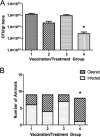Resolution of Staphylococcus aureus biofilm infection using vaccination and antibiotic treatment
- PMID: 21220484
- PMCID: PMC3067561
- DOI: 10.1128/IAI.00451-10
Resolution of Staphylococcus aureus biofilm infection using vaccination and antibiotic treatment
Abstract
Staphylococcus aureus infections, particularly those from methicillin-resistant strains (i.e., MRSA), are reaching epidemic proportions, with no effective vaccine available. The vast number and transient expression of virulence factors in the infectious course of this pathogen have made the discovery of protective antigens particularly difficult. In addition, the divergent planktonic and biofilm modes of growth with their accompanying proteomic changes also demonstrate significant hindrances to vaccine development. In this study, a multicomponent vaccine was evaluated for its ability to clear a staphylococcal biofilm infection. Antigens (glucosaminidase, an ABC transporter lipoprotein, a conserved hypothetical protein, and a conserved lipoprotein) were chosen since they were found in previous studies to have upregulated and sustained expression in a biofilm, both in vitro and in vivo. Antibodies against these antigens were first used in microscopy studies to localize their expression in in vitro biofilms. Each of the four antigens showed heterogeneous production in various locations within the complex biofilm community in the biofilm. Based upon these studies, the four antigens were delivered simultaneously as a quadrivalent vaccine in order to compensate for this varied production. In addition, antibiotic treatment was also administered to clear the remaining nonattached planktonic cells since the vaccine antigens may have been biofilm specific. The results demonstrated that when vaccination was coupled with vancomycin treatment in a biofilm model of chronic osteomyelitis in rabbits, clinical and radiographic signs of infection significantly reduced by 67 and 82%, respectively, compared to infected animals that were either treated with vancomycin or left untreated. In contrast, vaccination alone resulted in a modest, and nonsignificant, decrease in clinical (34% reduction) and radiographic signs (9% reduction) of infection, compared to nonvaccinated animal groups untreated or treated with vancomycin. Lastly, MRSA biofilm infections were significantly cleared in 87.5% of vaccinated and antibiotic-treated animals, while antibiotics or vaccine alone could not significantly clear infection compared to controls (55.6, 22.2, and 33.3% clearance rates, respectively). This approach to vaccine development may lead to the generation of vaccines against other pathogenic biofilm bacteria.
Figures




References
Publication types
MeSH terms
Substances
Grants and funding
LinkOut - more resources
Full Text Sources
Other Literature Sources
Medical

